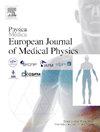Commissioning of a reference beam model-based Monte Carlo dose calculation algorithm for cranial stereotactic radiosurgery
IF 3.3
3区 医学
Q1 RADIOLOGY, NUCLEAR MEDICINE & MEDICAL IMAGING
Physica Medica-European Journal of Medical Physics
Pub Date : 2025-04-13
DOI:10.1016/j.ejmp.2025.104976
引用次数: 0
Abstract
Purpose
In treatment planning system (TPS) commissioning for stereotactic radiosurgery (SRS), the required measurements and precision necessary to generate an accurate beam model make the process taxing and time-consuming. Recently, Brainlab AG released reference beam models available for use with the Elements TPS. In this work, we detail our implementation of reference beam model-based Monte Carlo dose calculations for our Elements 4.0 TPS.
Methods
Depth dose, output factor, and beam profile measurements were used to select a reference beam model. 9 treatment plans encompassing the range of clinical use cases were created. Patient QA measurements were performed using a high-resolution detector array. Dose distributions were mapped to the QA array using the reference beam model with 1–2 mm grid resolution. Independent MU verifications were performed for each test plan. An end-to-end test was performed for final verification of system performance and data integrity.
Results
Acceptable agreement was demonstrated between measured data and the reference beam model. All QA gamma pass rates exceeded 95 %. Measured peak dose differences were over 5 % for targets with diameter <7 mm when using a 1.0 mm Monte Carlo grid resolution. 1 of the 46 tested arcs had over a 5 % difference between MU verification and the TPS-calculated MU. End-to-end testing verified system performance.
Conclusion
Validation testing demonstrated good agreement between the reference beam dataset and machine performance for targets with diameters ≥7 mm. The use of a reference beam model may significantly reduce measurement burden while mitigating potential failure modes associated with TPS commissioning.
基于参考光束模型的蒙特卡罗剂量计算算法在颅脑立体定向放射外科中的调试
目的:在立体定向放射外科(SRS)的治疗计划系统(TPS)调试中,生成准确的光束模型所需的测量和精度使该过程繁重且耗时。最近,Brainlab AG发布了用于Elements TPS的参考光束模型。在这项工作中,我们详细介绍了我们在Elements 4.0 TPS中基于参考光束模型的蒙特卡罗剂量计算的实现。方法采用深度剂量、输出因子和光束轮廓测量选择参考光束模型。创建了包含临床用例范围的9个治疗方案。使用高分辨率检测器阵列进行患者QA测量。使用参考光束模型将剂量分布映射到QA阵列,网格分辨率为1 - 2mm。对每个测试计划执行独立的MU验证。为了最终验证系统性能和数据完整性,进行了端到端测试。结果实测数据与参考光束模型吻合良好。所有QA伽玛通过率超过95%。当使用1.0 mm蒙特卡罗网格分辨率时,直径为7 mm的目标测量到的峰值剂量差异超过5%。46个测试电弧中有1个在MU验证和tps计算的MU之间有超过5%的差异。端到端测试验证了系统性能。结论验证测试表明,对于直径≥7 mm的目标,参考光束数据集与机器性能具有良好的一致性。使用参考光束模型可以显著减少测量负担,同时减少与TPS调试相关的潜在故障模式。
本文章由计算机程序翻译,如有差异,请以英文原文为准。
求助全文
约1分钟内获得全文
求助全文
来源期刊
CiteScore
6.80
自引率
14.70%
发文量
493
审稿时长
78 days
期刊介绍:
Physica Medica, European Journal of Medical Physics, publishing with Elsevier from 2007, provides an international forum for research and reviews on the following main topics:
Medical Imaging
Radiation Therapy
Radiation Protection
Measuring Systems and Signal Processing
Education and training in Medical Physics
Professional issues in Medical Physics.

 求助内容:
求助内容: 应助结果提醒方式:
应助结果提醒方式:


